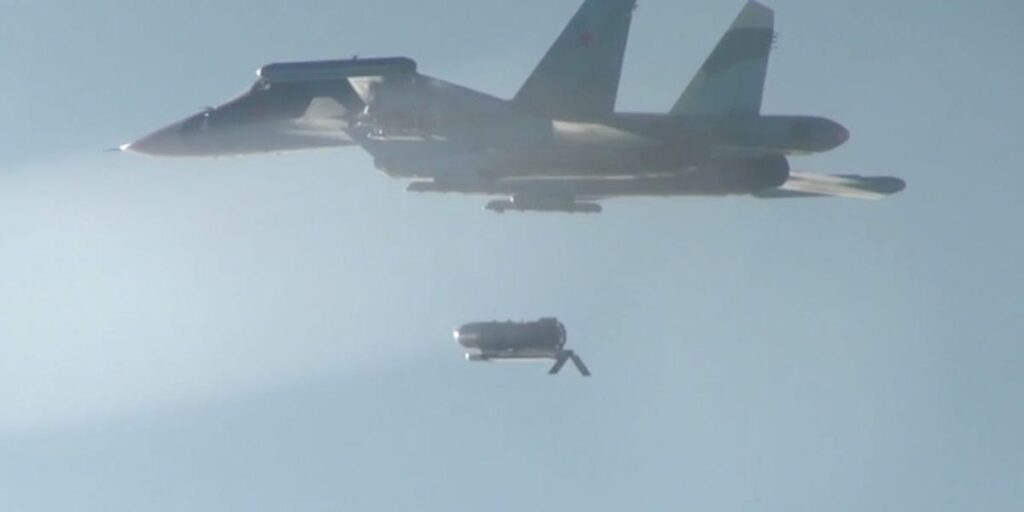
Ukrainian forces have successfully launched a drone attack on a Russian airbase in the Volgograd region, destroying at least two Su-34 fighter-bomber aircraft, according to a new Western intelligence assessment. The Marinovka airbase, located over 270 miles from the front lines, serves as a strategic fallback location for Russian jets relocated from more vulnerable bases.
The attack, carried out on Friday, utilized long-range drones and was a coordinated effort involving Ukraine’s SBU internal security agency, Special Operations Forces, and other military elements. This development underscores Ukraine’s ongoing efforts to weaken Russian air capabilities amid the ongoing conflict.
Strategic Importance of Marinovka Airbase
Marinovka has been a crucial site for Russia, not only for daily combat operations but also as a refuge for aircraft moved from threatened airbases. The British defense ministry confirmed the attack in a Tuesday intelligence update, noting that despite Russia’s efforts to disperse its fleet, its aviation remains vulnerable to Ukrainian strikes.
The Su-34 aircraft, known for carrying highly destructive glide bombs, were relocated to Marinovka from the Morozovsk airbase after it suffered a Ukrainian drone attack in August 2024. These dispersal efforts, however, have not fully shielded Russian aviation from Kyiv’s targeted operations.
The Threat of Glide Bombs
The Su-34 “Fullback” fleet poses a significant challenge for Ukraine due to its capability to deploy glide bombs. These munitions are unguided bombs equipped with kits that transform them into precision-guided weapons. Their short flight times and small radar signatures make them difficult to intercept, leading to devastating impacts on Ukrainian cities.
“Russia relies on its Su-34 fleet to execute huge amounts of daily sorties launching glide bombs,” the British defense ministry stated, adding that Moscow has lost more than 30 of these aircraft since the invasion began in February 2022.
Ukraine’s military has prioritized neutralizing this threat, conducting deep strikes on Su-34 aircraft, their airfields, and storage sites for glide bombs over the past year.
Impact and Implications
The recent strike on Marinovka highlights Ukraine’s relentless campaign to degrade Russian airpower. On Sunday, Ukrainian President Volodymyr Zelenskyy reported that Russian warplanes had launched nearly 1,100 glide bombs in the previous week, emphasizing the ongoing threat these weapons pose.
Meanwhile, Ukraine’s strategy has included targeting other Russian bases, such as a recent drone strike on helicopter operations in the occupied Crimean peninsula. These actions are part of a broader effort to disrupt Russian military logistics and capabilities.
Expert Opinions and Historical Context
Military analysts suggest that Ukraine’s ability to strike deep into Russian territory demonstrates a significant advancement in its drone warfare capabilities. According to defense expert Michael Kofman, “Ukraine’s drone strikes are not just symbolic; they are strategically aimed at undermining Russia’s operational capacity.”
Historically, air superiority has played a crucial role in modern conflicts. The ongoing struggle for control of the skies in Ukraine echoes past military engagements where air dominance was pivotal. The current situation further emphasizes the evolving nature of warfare, with drones becoming increasingly central to military strategy.
Looking Ahead
As the conflict continues, the effectiveness of Ukraine’s drone strikes could influence future military tactics and strategies. The ongoing attrition of Russian aircraft may compel Moscow to reconsider its deployment strategies and reinforce its air defenses.
For Ukraine, sustaining its momentum in targeting Russian aviation will be crucial. The international community’s support, in terms of intelligence and military aid, remains vital to Kyiv’s efforts to counter the Russian threat effectively.
In conclusion, the attack on Marinovka is a testament to Ukraine’s strategic resilience and its commitment to weakening Russian military capabilities. As both nations continue to adapt their strategies, the outcome of this aerial contest will likely have significant implications for the broader conflict.




